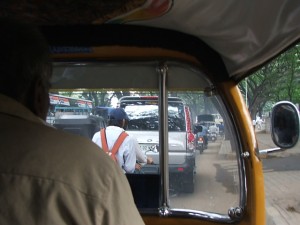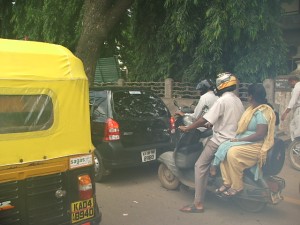2010-11-22 (2021-09-06): It is difficult for any foreign news item, no matter how important, to penetrate the current economic media haze in Ireland and Europe … but latest reports from India put the casualty list after the Five-Storey Residential Building Collapse at Lalita Park in East Dilli’s Laxmi Nagar Area … which occurred on Monday evening (local time), 15 November 2010 … at 69 people dead, 82 injured, with perhaps as many as another 20 people still missing.
The Occupants of 38 Similar Neighbouring Properties have been told to immediately vacate the buildings by Dilli’s Municipal Authority.
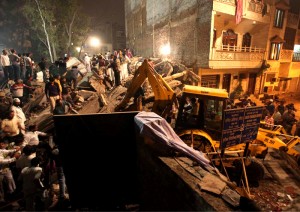
.
Faulty Construction appears to have been the principal cause for this serious collapse, according to media reports. It may also have been an extra storey illegally added to an original, weak building structure … and/or heavy water logging of the building’s basement from the nearby Yamuna River during recent storms.
Dilli … its local name … is a very old and large city, and is the Capital of India. New Delhi refers to the relatively more recent British Imperial Quarter … the urban plan of which and its principal buildings were designed by the British Architect, Edwin Landseer Lutyens (1869-1944).
.
Within India, today, there is a strong political desire to achieve ‘Developed Country’ Status by 2020. However, in Developed Countries … Collapse Level Events (CLE’s) are completely unacceptable … witness the public reaction to the WTC Building Collapses on 9-11 in New York City.
The 2005 National Building Code of India … a copy of which is close at hand in my Dublin Office … is not mandatory. It closely resembles the informal (i.e. not legal), but prescriptive, ‘Draft’, ‘Revised Draft’ and ‘Proposed’ Irish Building Regulations dating from the 1970’s and 1980’s … another Irish solution to an Irish problem ! The 2005 Indian Code has been drafted to deal with a large range of simple building types, their construction and related issues … certainly not any sort of Iconic, High-Rise Building of Innovative Design. Anyway, the Code is still only at the initial stages of being adopted in India’s different States. AND … there is not yet in place a National System of Local Building Control, or Independent Technical Control … never mind an ‘Effective’ System of Control !
In a lightly regulated European legislative environment … it may come as a surprise to find out that the level of non-compliance on building sites in France, for example, has been placed as high as 68%, according to a colleague from CSTB (Centre Scientifique et Technique du Bâtiment) … the rate of non-compliance which was found by Energy Ireland (SEAI) on Irish building sites was 70%.
In India’s unregulated legislative environment … higher levels of non-compliance should be expected amongst indigenous building organizations. AND … the percentage rate of non-compliance with foreign building organizations should be assumed to at least match those European figures quoted above.
There is a further complication in India and most of the rest of the developing world, however, because USA building design consultants will typically use one of the United States of America’s National Model Building Codes (including the International Building Code, which is also a U.S. National Model Building Code) … in preference to local building codes … whatever the local codes do, or do not, say. We have a long experience of this approach in Ireland ! BUT … the USA Model Building Codes are not being adapted to suit local site conditions, building practices, safety factors, etc. It sounds messy … and it is very messy !!
.
A few quick words about INDIA (Bhārata or Bharat, in Sanskrit) … a federal republic and a burgeoning country of extreme contrasts … which has a population of some 1,339,330,514 People (July 2021 estimated, USA CIA World Factbook).
Rapid economic development has driven India to prominence on the world stage … (refer to a current view on India’s Cyber Profile) … despite pressing problems such as significant overpopulation, extensive poverty and a startling degree of social inequity, environmental degradation, such as deforestation, soil erosion, overgrazing, desertification, air pollution from industrial effluents and vehicle emissions, water pollution from raw sewage and run-off of agricultural pesticides … and the widespread corruption which is a natural consequence following an extended period of harsh and abusive external imperial domination. India became an independent country in 1947.
For the last few years, I have been travelling to this beautiful, complex land … from Chennai (Madras) and Bengaluru (Bangalore) in the south … to Dilli in the north. Over 70 years before … my father, a native of Midleton in County Cork, was a teacher in Kolkata (Calcutta) and further north than Dilli. He was trapped, there, from coming home during the 2nd World War (1939-1945).
For me, it has been a warm and rewarding experience to meet the people of India.
And … I am also very grateful for the hospitality shown by FSAI (Fire & Security Association of India). Working together, we have successfully set a future direction for the FSAI’s National Fire Safety Agenda in India.
.
Less recently in the news and, it seems, always for the wrong reasons … Mumbai (Bombay) … where of the approximately 14 Million (1.4 Crore, an Indian Unit of Measure) People living in this western city … capital of the State of Maharashtra, and the financial and entertainment capital of the country … an estimated 7,500,000 (75 Lakhs, an Indian Unit of Measure) People survive in its Slums.
Mumbai is also located in a Seismically Active Zone, due to the presence of 23 fault lines in the region …
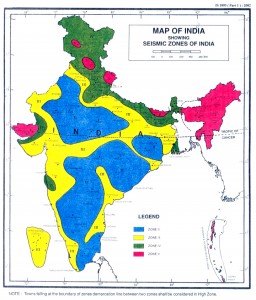
.
During past years, a pattern of extraordinarily violent ‘Hive-Attacks’ have been carried out in Mumbai, with the aim of causing widespread terror amongst the general population and disrupting the city’s important Social & Economic Environments. The attacks have involved the strategic targeting of Built Environment Places of Public Resort, Iconic Buildings, High-Rise Buildings, Buildings having a Critical Function, Transport Infrastructure and Service Utilities:
- On 12 March 1993 … a series of 13 co-ordinated bombings … up until that date, the most destructive bomb explosions in Indian history … beginning at the Stock Exchange Building … resulted in 257 deaths and over 700 injuries.
- On 11 July 2006 … 209 people were killed and over 700 injured when seven bombs exploded on the city’s commuter trains.
- Commencing on 26 November 2008, and lasting for three days … a series of ten co-ordinated attacks resulted in 175 deaths, 308 injuries, and severe damage to a number of luxury hotels and historical landmarks.
.
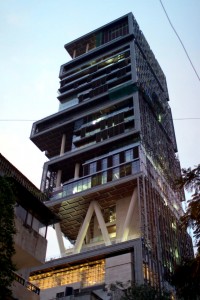
How strange it is, then, in this particular city … that at the end of October 2010 … after seven years of construction … an Indian businessman, Shri Mukesh Ambani, and his family … should choose to occupy their own 27 floor/173 metre tall Private Mansion … an Iconic, High-Rise Building of Innovative Design … within the near-sight of millions of slum dwellers ! The building is called ‘Antilia’ … the name of a mythical island in the Atlantic Ocean, lying to the west of Portugal ?!?
OK … Let’s Get the Easy Bits Over First …
1. Architecturally … and somebody, somewhere needs to say this … ‘Antilia’ is a mother of an ugly building. There is an old joke about a committee starting out to design a horse, and ending up with a camel. In this case, a group of people started to design an impressive building, and ended up with a spotty rhinoceros !
2. From the point of view of Sustainable Human & Social Development … consider the resources used in the design, construction and operation of this mother … an architectural phallic symbol of obscene opulence and cheap looking ‘bling-bling’ … in close proximity to extensive and deep-rooted slum poverty. It may be ‘Green'(?) … BUT … this building is certainly Anti-Sustainable ! Is it any wonder that a Class Action has recently been taken against the U.S. Green Building Council and its LEED (Leadership in Energy and Environmental Design) Building Rating System in the U.S. Courts ?
The Difficult Issues …
3. Structural Resilience … I would really like to be assured, by a person competent to do so, that ‘Antilia’ has actually been designed to withstand “a magnitude-8 earthquake” (according to local media reports), i.e. no significant damage will occur to the structure or fabric of the building.
AND … that ‘Antilia’ has been designed to properly resist disproportionate damage in the event that any “military grade explosions” (according to local media reports) happen in the building, i.e. no significant damage will occur to the building’s structure.
But … why only “military grade explosions” ? If an ‘incident’ does take place in the building, it will not be the poorly equipped Indian Army who will be placing the ‘ordinary’ explosives … and the Army will not have the required expertise to place the explosives in the most vulnerable part of the structure.
Never assume that the people who plan these sorts of ‘incidents’ are anything other than highly motivated, intelligent and technically competent !
4. Fire Protection & Safety … this requires much repetition … but the 2005 National Building Code of India cannot deal adequately with this type of building … an Iconic, High-Rise Building of Innovative Design. AND, most obviously … the 2005 Indian Code does not incorporate any of the important Recommendations contained in the 2005 & 2008 NIST(USA) Reports on the 9-11 WTC Buildings 1,2 & 7 Collapses. I have suggested that this be done, with urgency, during an upcoming revision to the Code … but there is resistance !
WTC 9-11 in New York City exposed a catastrophic failure … at all levels … in all of OUR common practices and procedures (architectural, engineering, first emergency response, regulatory, legislative, etc., etc) … used to design, construct and operate buildings generally !
.
So … what does ‘Antilia’ … say about the Man … the Institutions of Governance and State Administration within Maharashtra … and India generally … at this time ???
Has this Man been well served by His Advisors … technical and otherwise ????
.
.
END
